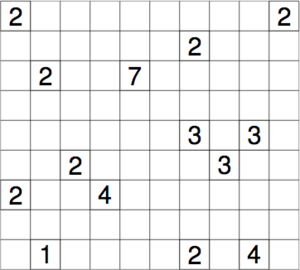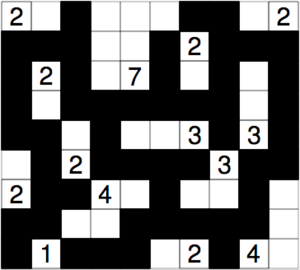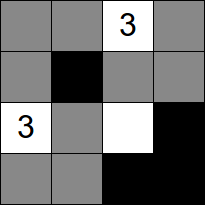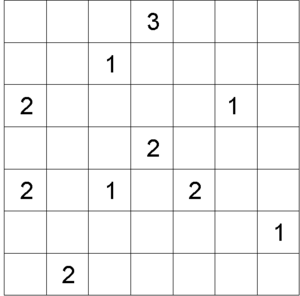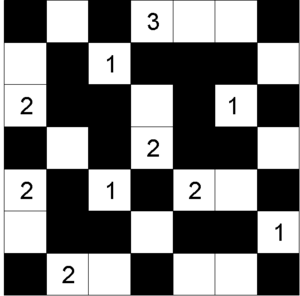Nurikabe (puzzle) facts for kids
Nurikabe (pronounced "noo-ree-kah-beh") is a fun logic puzzle. It's played on a grid, much like a crossword or Sudoku. The name comes from a Japanese legend about an invisible wall. This wall, called Nurikabe, would block roads.
The puzzle was created by a Japanese company called Nikoli. They are famous for inventing many popular puzzles. Other names for Nurikabe include Cell Structure and Islands in the Stream.
Contents
How to Play Nurikabe
The puzzle uses a grid of squares, usually shaped like a rectangle. Some squares already have numbers in them. Your job is to color each square either black or white.
Here are the main rules:
- Islands and Sea: White squares form "islands." Black squares form the "sea."
- Connections: Squares are connected if they touch side-by-side (up, down, left, or right). They are not connected if they only touch at a corner.
- Numbered Squares: Every numbered square must be part of a white "island." The number tells you how many white squares are in that island.
- One Number Per Island: Each white island can only have one numbered square.
- One Sea: All the black squares must connect to form one big "sea."
- No Black Pools: The black "sea" cannot have any 2x2 blocks of black squares. Imagine a small square made of four black squares. This is not allowed!
When you solve the puzzle, there should be only one correct answer.
Solving Nurikabe Puzzles
You don't need to guess to solve a Nurikabe puzzle. You can use smart steps and rules to figure out where to color. Many puzzles need you to think about both black and white squares. Sometimes, marking a square white will force another square to be black. The same goes for marking squares black.
Basic Solving Tips
Here are some common ways to start and solve a Nurikabe puzzle:
- Islands Don't Touch: White islands can only touch at their corners. If you see two numbers (or parts of islands) next to each other, the square between them must be black. This is a great way to begin!
- Complete Islands: If an island has all the white squares it needs (its number is reached), then all squares touching its sides must be black. For example, if a square has the number '1', it's an island by itself. All squares around it must be black.
- No Black Pools: Remember, no 2x2 black squares are allowed. If three black squares form an "L" shape, the square in the bend (diagonally from the corner of the L) must be white. This stops a 2x2 black area from forming.
- Connecting the Sea: All black squares must be connected. If a black area only has one way to connect to other black squares, that path must be black.
- Connecting Islands: All white squares must belong to an island. If a white area doesn't have a number yet, and it can only connect to one numbered island, then that connection path must be white.
- Unreachable Squares: Sometimes, a square can't connect to any number. It might be too far or blocked. These "unreachable" squares must be black.
Advanced Solving Tips
- Corner Connections: If two islands are close and could connect through a single white square, but they would then touch at a 90-degree angle, the square between them must be black. This stops the two islands from joining.
- Testing Squares: Sometimes, you can test if a square should be black. If making it black creates a problem (like a 2x2 black area or disconnected black squares), then that square must be white.
Related Puzzles
Other puzzles are similar to Nurikabe. They also involve coloring squares black or white.
- LITS and Mochikoro are puzzles also created by Nikoli. They use similar ideas to Nurikabe.
- Atsumari is like Nurikabe, but it uses a grid of hexagons (six-sided shapes) instead of squares.
Mochikoro is a special type of Nurikabe puzzle with slightly different rules:
- Numbered squares are part of white areas, and the number shows how many squares are in that white area. Some white areas might not have a number.
- All white areas must connect diagonally.
- The black squares cannot form a 2x2 area or larger.
See also
 In Spanish: Nurikabe para niños
In Spanish: Nurikabe para niños


